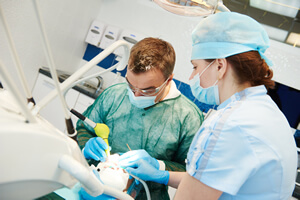Tooth Extractions in Gillette
If you’re having pain from a diseased tooth and you think you may need a tooth extraction, contact us now. Waiting to have your tooth extraction can cause damage to neighboring teeth and actually complicate the problem.
Big Horn Dental Clinic Tooth Extraction
A tooth extraction refers to the surgical removal of a tooth from the mouth by a dentist or oral surgeon and is one of the more common dental emergencies. Our dentists at Big Horn Dental – Dr. Lee and Dr Nichols frequently perform tooth extractions as part of our dental care services. We’re able to perform the tooth extraction procedure for both a tooth that is easy to remove – as well as more complex tooth extractions for teeth that are impacted or broken that require more extensive dental surgery.

Reasons for Tooth Extraction in Gillette
There are several reasons why a tooth may need to be extracted in Gillette. Some common causes include:
- Severe Tooth Decay: When a tooth is too decayed to be saved, extraction may be necessary.
- Crowding: If there isn’t enough space in your mouth, oral surgery may be required to remove one or more teeth to make way for others.
- Gum Disease: In advanced cases, gum disease can weaken the teeth and surrounding bone, leading to the need for extractions.
- Impaction: In addition to dealing with a decayed or damaged tooth, wisdom teeth extraction can also become necessary. Wisdom teeth have a tendency to become impacted, which can cause pain and infection. Oral surgery is required to remove the impacted wisdom tooth (or wisdom teeth) and provide the necessary space for your teeth.
Preparing for Tooth Extraction
Consultation and Evaluation
Before the extraction, you will meet with our dentists for a consultation. This visit is essential for Dr. Lee and Dr. Nichols to properly assess your overall oral health and the specific tooth needing removal.
Our dentists will conduct an oral examination and may take X-rays to evaluate the condition of your tooth and surrounding bone.
During this time, it’s vital to discuss your medical history, any medications you take, and any concerns you have about the procedure. This information helps our dentist create a personalized plan for your extraction.
Pre-Extraction Instructions
Your dentist will provide specific instructions to follow before the extraction. These may include:
- Avoiding certain foods: Stay away from hard or crunchy foods that could irritate your mouth.
- Medications: Take prescribed medications as directed, and inform your dentist of any changes.
- Fasting: If sedation is involved, you may need to fast for a certain number of hours before the procedure.
Additionally, be sure to arrange for someone to drive you home after the extraction, especially if you will receive sedation.
Understanding the Risks
Tooth extractions, like any medical procedure, come with certain risks. It’s crucial to understand these before proceeding. Potential risks include:
- Infection: There’s a risk of developing an infection at the extraction site, which may require further treatment.
- Dry socket: This painful condition can occur if the blood clot at the extraction site of the damaged tooth dislodges before healing.
- Nerve damage: In rare cases, nerve injury can happen, leading to numbness or pain in the surrounding area.
Discuss these risks with your dentist to ensure you are fully informed and prepared for the procedure.
Procedure Process
Tooth extractions are a common dental procedure. Understanding the process can help ease any concerns you may have. This section covers anesthesia options, the step-by-step extraction procedure, and post-extraction care.
Anesthesia Options in Gillette
When preparing for a tooth extraction, your dentist will discuss anesthesia options. The two main types are local anesthesia and general anesthesia.
- Local Anesthesia: This numbs the specific area around the tooth. It allows you to stay awake while feeling no pain during the procedure.
- IV Sedation: This option puts you to sleep and is usually used for more complex extractions, such as wisdom teeth removal. Big Horn Dental Clinic is the only dental practice in Campbell County offering certified IV Sedation as part of our overall dental services. Only a very small percentage of dentists nationwide are accredited and able perform this procedure.
Step-by-Step Extraction Process
The extraction process typically follows these steps:
- Assessment:Your dentist will examine the tooth and take X-rays to understand its position.
- Anesthesia: Based on your choice and dental needs, the dentist will administer the chosen anesthesia to ensure you are comfortable.
- Extraction: For simple extractions, the dentist loosens the tooth with special tools and removes it. If the tooth is impacted, surgeons might need to cut into the gum with a more complex oral surgery procedure.
- Aftercare Instructions: Once the tooth is removed, the dentist will provide guidelines to care for the extraction site.
The entire procedure usually takes about 30 to 60 minutes, depending on the complexity.
Post-Extraction Care and Guidelines
After your tooth extraction, you’ll follow the dental care instructions provided by your dentist. In most cases, these are the general after care guidelines to promote healing:
- Rest: Take it easy for at least 24 hours after the dental treatment.
- Manage Pain: Use prescribed pain relievers or over-the-counter options as needed.
- Avoid Sucking: Don’t use straws or spit, as this can dislodge the blood clot.
- Diet: Stick to soft foods like yogurt, applesauce, and soup. Avoid hard or hot foods for a few days.
- Watch for Complications: Keep an eye out for unusual symptoms like excessive bleeding or signs of infection. Contact your dentist if you notice anything concerning.
Cost and Insurance
Payment Options and Assistance
There are many ways to cover the cost of your tooth extraction.
Care Credit Financing Program
For patients who don’t have a dental benefits or dental insurance. plan, we’ve made it easy to get the dental work with the CareCredit Financing program. This is a widely accepted dental financing program allowing you to cover the cost of dental treatment – including tooth extractions – through affordable monthly installments.
Smile Savings Plan
For non-insured patients, you get the following benefits with our in house Smile Savings Plan that helps to cover the cost of general dentistry,oral surgery, and restorative dentistry procedures:
- 2 Free Cleanings Per Year
- 2 Free Dental Exams Per Year
- Oral Cancer Screening Once Per Year
- Fluoride Treatment Twice a year
- 5% off on General and Major Dental Procedures (this helps to cover the cost of your
- 10% off on any additional Periodontal Treatments (a savings of over $600 annually)
Don’t Wait to Get Dental Treatment
Almost all dental issues don’t go away on their own. Delaying necessary dental treatment can have a significantly negative financial impact, as well as damage your overall oral health.
Consider this scenario: You have a damaged tooth that needs to be extracted. Damaged teeth can easily become infected. Infection may spread to neighboring teeth and gums, potentially resulting in tooth loss – beyond the originally damaged tooth. Periodontal disease and jaw bone deterioration is also a possibility. The loss of a tooth can trigger a cascading effect, necessitating dental implants to prevent teeth shifting and further bone loss.
Preventive Care
Preventive care is key to avoiding tooth extractions. Regular dental check-ups can help detect issues early and can in many cases prevent a tooth from deteriorating and requiring extraction. These visits should include cleanings, X-rays, and assessments of your oral health.
Practicing good oral hygiene at home is also essential. This includes brushing twice a day and flossing daily. Following a balanced diet low in sugary foods can also contribute to healthier teeth.
Restorative Options
Tooth extraction will leave a patient with a missing tooth. A missing tooth creates a void in your mouth and can trigger a cascade of negative effects including shifting of adjacent teeth, bite misalignment, and bone loss in the jaw. This misalignment can lead to abnormal chewing forces and increased wear on other teeth, potentially affecting overall oral health and even the temporomandibular joint.
A dental implant should be considered because it replaces both the tooth and its root, stabilizing the surrounding teeth, stimulating the bone to prevent further loss, and restoring proper function and aesthetics.
While not as good as dental implants (but considerably less expensive), dentures can replace multiple missing teeth and improve your appearance.





